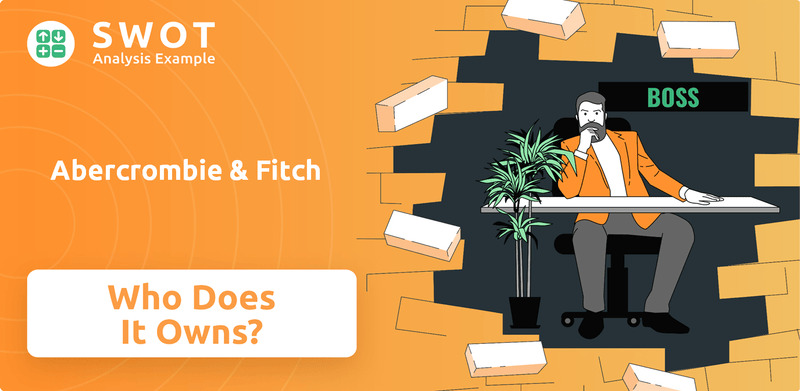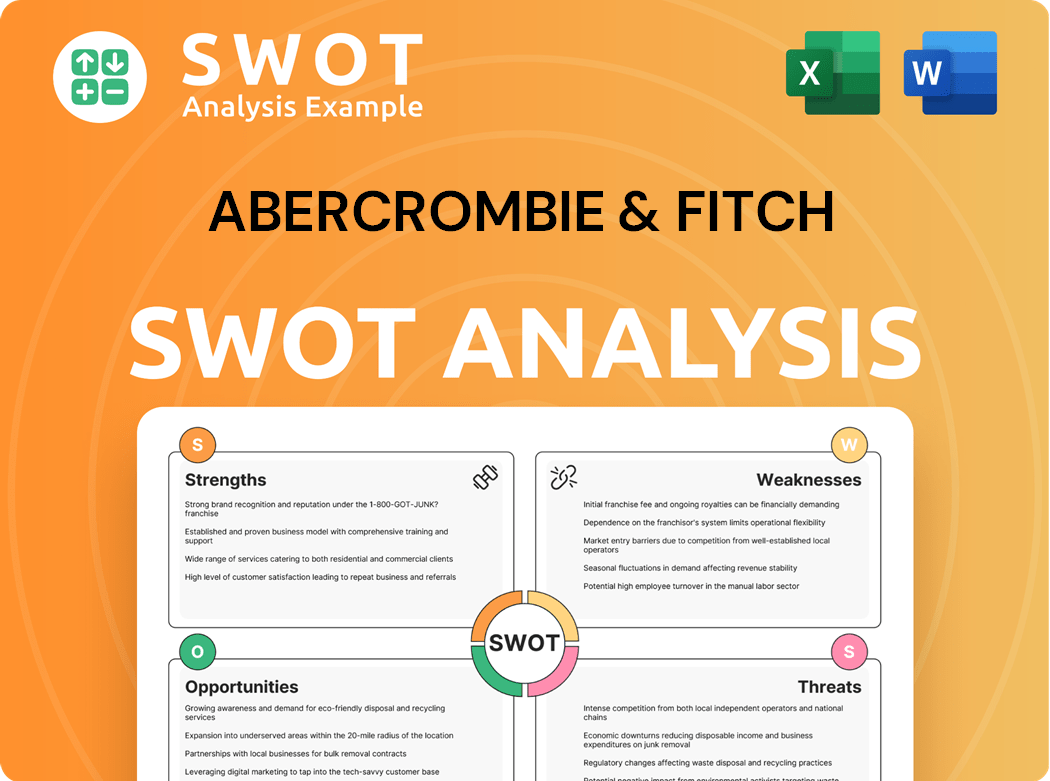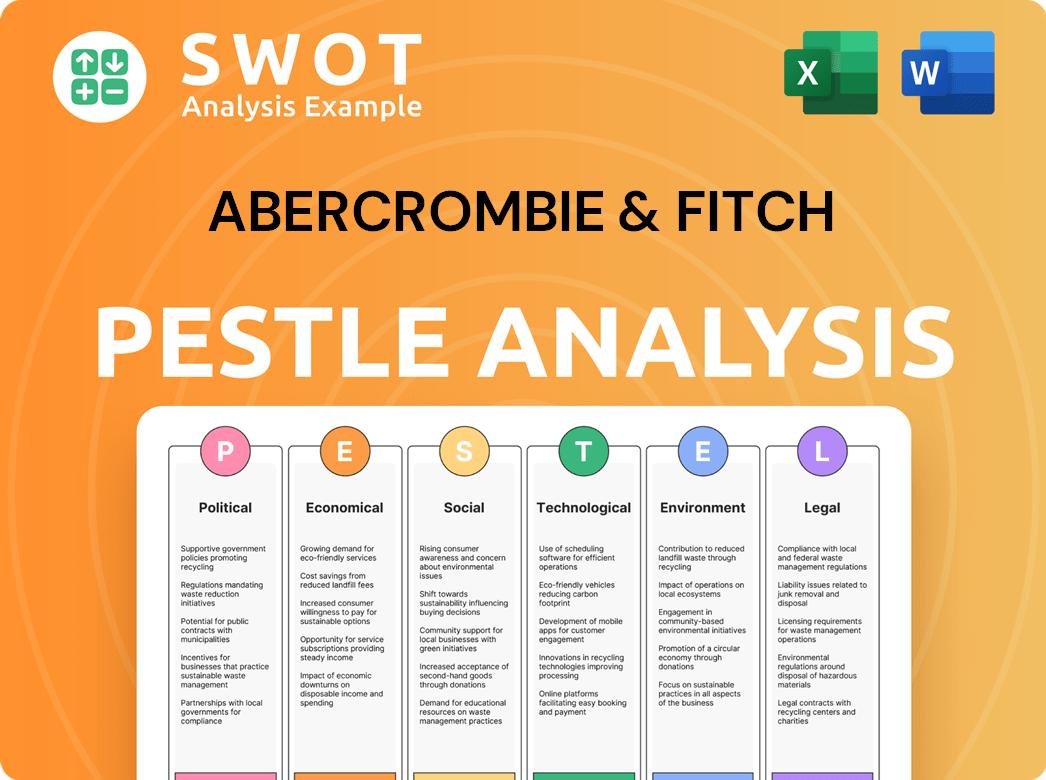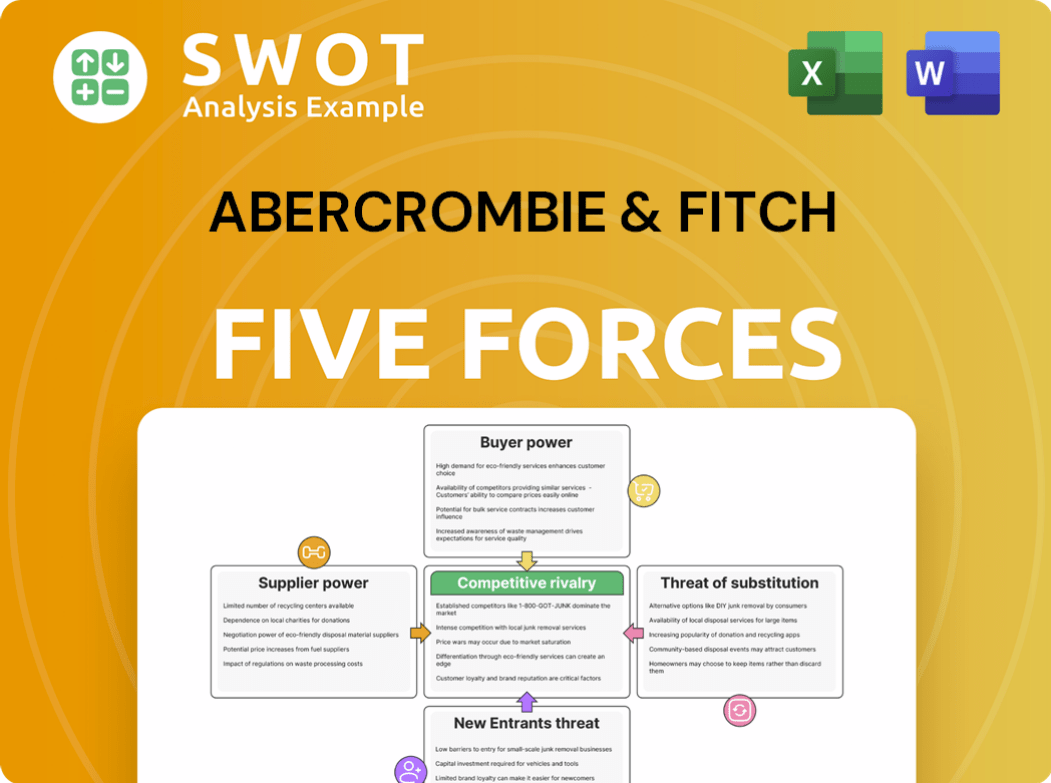Abercrombie & Fitch Bundle
Who Really Owns Abercrombie & Fitch?
Ever wondered who pulls the strings at Abercrombie & Fitch, a brand that has evolved from an outfitter for elite outdoorsmen to a global retail powerhouse? Understanding the Abercrombie & Fitch SWOT Analysis is just the beginning. The Abercrombie & Fitch ownership structure is a fascinating story of transformation, reflecting shifts in market dynamics and strategic direction.

This exploration into Abercrombie & Fitch ownership will reveal the key players influencing the company's trajectory, from its founding in 1892 to its current status as a publicly traded entity. We'll uncover the impact of institutional investors, individual shareholders, and insiders on Abercrombie & Fitch's corporate structure and financial performance. Discover the answers to questions like: Who is the current owner of Abercrombie & Fitch? Who controls Abercrombie & Fitch? and how these factors shape the brand's future.
Who Founded Abercrombie & Fitch?
The story of the Abercrombie & Fitch company begins in 1892, with David T. Abercrombie as the founder. Initially, the company, then known as Abercrombie Co., catered to an elite clientele in New York City, specializing in high-end outdoor gear.
A significant shift occurred in 1900 when Ezra Fitch, a loyal customer, became a co-founder after acquiring a substantial stake. The company was later incorporated and renamed Abercrombie & Fitch Co. in 1904, marking a pivotal moment in its history.
The evolution of the Abercrombie & Fitch ownership structure reflects the changing vision for the company. This early period set the stage for the brand's future, influencing its direction and appeal.
David T. Abercrombie, an outdoorsman, established Abercrombie Co. in 1892. The company's initial focus was on providing premium outdoor clothing and equipment.
Ezra Fitch, a customer, became a co-founder in 1900. This partnership led to the incorporation and renaming of the company in 1904.
Abercrombie wanted to focus on professional gear, while Fitch aimed to broaden the appeal. This difference in strategy led to Abercrombie's departure in 1907.
After Abercrombie's exit, Ezra Fitch became the sole owner until 1928. Under his leadership, the company expanded its offerings and reach.
By 1909, Abercrombie & Fitch was mailing over 50,000 catalogs worldwide. The company introduced women's clothing in 1910.
Understanding the target market of Abercrombie & Fitch requires looking back at its early ownership and strategic shifts.
The Abercrombie & Fitch ownership history reveals a transition from a specialized outdoor gear provider to a broader retailer. The shift from Abercrombie's focus to Fitch's vision marked a crucial turning point.
- David Abercrombie founded the company in 1892, focusing on high-end outdoor gear.
- Ezra Fitch became a co-founder in 1900 and sole owner after 1907.
- The company expanded its offerings and reach under Fitch's leadership.
- The early ownership structure shaped the company's direction and brand identity.
Abercrombie & Fitch SWOT Analysis
- Complete SWOT Breakdown
- Fully Customizable
- Editable in Excel & Word
- Professional Formatting
- Investor-Ready Format

How Has Abercrombie & Fitch’s Ownership Changed Over Time?
The journey of the Abercrombie & Fitch company through various ownership structures reflects its evolution. After Ezra Fitch's departure in 1928, the company saw changes in leadership and faced financial difficulties, leading to bankruptcy in 1976. Oshman's Sporting Goods acquired the name and mailing list in 1978, marking a transition phase. The pivotal moment came in 1988 when The Limited (later L Brands) acquired Abercrombie & Fitch, setting the stage for its transformation and eventual spin-off.
Abercrombie & Fitch Co. became a publicly traded entity in 1996. As of May 2025, the company has a market capitalization of approximately $6.87 billion, indicating its substantial presence in the market. The ownership is primarily held by institutional investors, with insiders and public/individual investors holding the remaining shares. This structure highlights the company's integration into the broader financial landscape and its reliance on diverse investor interests.
| Ownership Milestone | Year | Details |
|---|---|---|
| Ezra Fitch's Retirement | 1928 | Marked a transition in leadership. |
| Bankruptcy Filing | 1976 | Resulted from financial difficulties. |
| Acquisition by Oshman's | 1978 | Led to a relaunch as a mail-order retailer. |
| Acquisition by The Limited | 1988 | Initiated a shift in focus and eventual IPO. |
| Initial Public Offering (IPO) | 1996 | Abercrombie & Fitch Co. became publicly traded. |
As of June 2025, major institutional shareholders include BlackRock, Inc., and Vanguard Group Inc. Vanguard is the noted owner of the most shares. This concentration of ownership among institutional investors underscores their significant influence on the company's strategic decisions and financial performance. Understanding the ownership structure provides insights into the company's governance and its alignment with investor interests.
The ownership of Abercrombie & Fitch has evolved significantly, from private ownership to a publicly traded company. Institutional investors hold the majority of shares, influencing company decisions. Key shareholders include BlackRock and Vanguard, with Vanguard holding the most shares.
- Publicly traded since 1996.
- Market capitalization of approximately $6.87 billion as of May 2025.
- Institutional investors hold a significant portion of the stock.
- Vanguard is a major shareholder.
Abercrombie & Fitch PESTLE Analysis
- Covers All 6 PESTLE Categories
- No Research Needed – Save Hours of Work
- Built by Experts, Trusted by Consultants
- Instant Download, Ready to Use
- 100% Editable, Fully Customizable

Who Sits on Abercrombie & Fitch’s Board?
The current board of directors of the Abercrombie & Fitch company plays a vital role in its governance and strategic direction. As of April 15, 2024, the board nominated nine of the existing ten directors for election at the Annual Meeting to serve until the 2025 Annual Meeting of Stockholders. The composition includes a mix of members, some representing major shareholders and others serving in independent roles. The company's CEO, Fran Horowitz, is a key member of the board.
The board's structure reflects the company's commitment to sound corporate governance. The board members and executive officers collectively held 1,319,047 shares, representing 2.58% of the class as of April 15, 2024. This ownership structure helps align the interests of the board with those of the shareholders, promoting responsible decision-making and long-term value creation. Understanding the board's composition is crucial for anyone looking into the Abercrombie & Fitch owner structure.
| Board Member | Title | Shares Held (as of April 15, 2024) |
|---|---|---|
| Fran Horowitz | CEO & Director | 925,520 |
| William J. Simon | Chairman of the Board | 11,500 |
| Jonathan E. Komp | Director | 10,000 |
The voting structure at Abercrombie & Fitch Co. is primarily based on a one-share-one-vote system for its Class A Common Stock, which is the only outstanding common equity. For meetings called by the Board of Directors, a quorum requires the presence of holders entitled to exercise at least one-third of the voting power. For meetings called by other parties, a majority of the voting power is needed for a quorum. Recent filings highlight ongoing governance practices, including the annual election of directors and advisory votes on executive compensation. To delve deeper into the specifics of how the company generates revenue, consider exploring the Revenue Streams & Business Model of Abercrombie & Fitch.
The board of directors is pivotal in overseeing Abercrombie & Fitch's operations and strategy.
- The CEO and other executives hold a significant number of shares, aligning their interests with shareholders.
- Voting rights are primarily based on a one-share-one-vote system.
- Governance practices include annual director elections and advisory votes on executive compensation.
- Understanding the board's composition is key to understanding who controls Abercrombie & Fitch.
Abercrombie & Fitch Business Model Canvas
- Complete 9-Block Business Model Canvas
- Effortlessly Communicate Your Business Strategy
- Investor-Ready BMC Format
- 100% Editable and Customizable
- Clear and Structured Layout

What Recent Changes Have Shaped Abercrombie & Fitch’s Ownership Landscape?
Over the past few years, the Abercrombie & Fitch company has focused on profitable growth, which has influenced its ownership profile. For fiscal year 2024, the company reported net sales of $4.95 billion, a 16% increase from 2023, with a full-year operating margin of 15.0%. This strong performance has led to significant share repurchase programs, impacting who owns Abercrombie & Fitch.
During fiscal year 2024, the company repurchased 1.6 million shares for $230 million, reducing shares outstanding by 3% as of February 3, 2024. In the first quarter of fiscal 2025, they repurchased 2.6 million shares for approximately $200 million, a 5% reduction in shares outstanding before stock compensation as of February 1, 2025. This marks the fifth consecutive quarter of share repurchases. In March 2025, a new $1.3 billion stock repurchase program was authorized, replacing the 2021 authorization, with plans to repurchase $400 million in shares for 2025. These buybacks increase the ownership percentage of existing shareholders.
Industry trends indicate increased institutional ownership in Abercrombie & Fitch Co. The current leadership, including CEO Fran Horowitz, has driven the company's turnaround. The company aims for net sales growth between 3% and 5% and an operating margin of 14% to 15% for fiscal year 2025. These financial goals, combined with ongoing share repurchases, show a commitment to enhancing shareholder value, influencing who controls Abercrombie & Fitch.
The company has been actively repurchasing shares, reducing the total number of outstanding shares. This strategy potentially increases the ownership stake of existing shareholders and can boost the stock's value.
There's an increasing trend of institutional investors holding a larger portion of the company's stock. This suggests confidence in the company's strategic direction and financial performance by large investors.
Abercrombie & Fitch has shown strong financial results, including increased net sales and healthy operating margins. These positive financials often attract and retain investors, impacting the ownership structure.
The current leadership team, particularly CEO Fran Horowitz, has played a key role in the company's turnaround. Their strategic decisions influence investor confidence and, consequently, ownership trends.
Abercrombie & Fitch Porter's Five Forces Analysis
- Covers All 5 Competitive Forces in Detail
- Structured for Consultants, Students, and Founders
- 100% Editable in Microsoft Word & Excel
- Instant Digital Download – Use Immediately
- Compatible with Mac & PC – Fully Unlocked

Related Blogs
- What are Mission Vision & Core Values of Abercrombie & Fitch Company?
- What is Competitive Landscape of Abercrombie & Fitch Company?
- What is Growth Strategy and Future Prospects of Abercrombie & Fitch Company?
- How Does Abercrombie & Fitch Company Work?
- What is Sales and Marketing Strategy of Abercrombie & Fitch Company?
- What is Brief History of Abercrombie & Fitch Company?
- What is Customer Demographics and Target Market of Abercrombie & Fitch Company?
Disclaimer
All information, articles, and product details provided on this website are for general informational and educational purposes only. We do not claim any ownership over, nor do we intend to infringe upon, any trademarks, copyrights, logos, brand names, or other intellectual property mentioned or depicted on this site. Such intellectual property remains the property of its respective owners, and any references here are made solely for identification or informational purposes, without implying any affiliation, endorsement, or partnership.
We make no representations or warranties, express or implied, regarding the accuracy, completeness, or suitability of any content or products presented. Nothing on this website should be construed as legal, tax, investment, financial, medical, or other professional advice. In addition, no part of this site—including articles or product references—constitutes a solicitation, recommendation, endorsement, advertisement, or offer to buy or sell any securities, franchises, or other financial instruments, particularly in jurisdictions where such activity would be unlawful.
All content is of a general nature and may not address the specific circumstances of any individual or entity. It is not a substitute for professional advice or services. Any actions you take based on the information provided here are strictly at your own risk. You accept full responsibility for any decisions or outcomes arising from your use of this website and agree to release us from any liability in connection with your use of, or reliance upon, the content or products found herein.